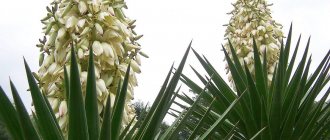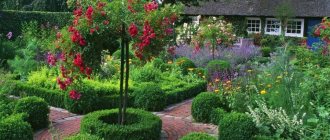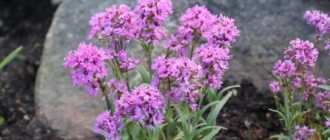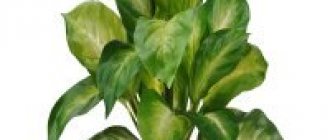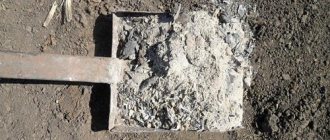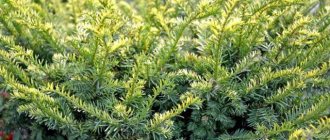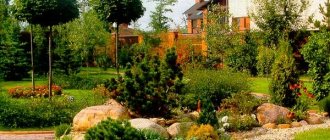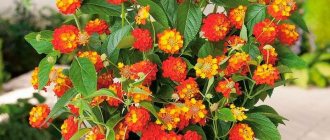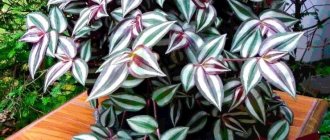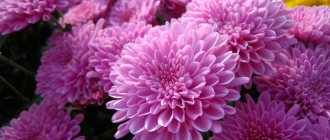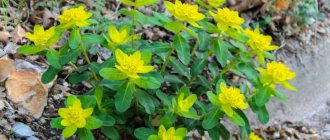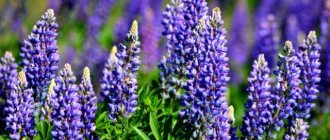The genus Loosestrife is represented by herbaceous plants that can be annual, perennial or biennial. This genus is a representative of the Primrose family. This plant was called loosestrife, because its foliage is very similar to willow (in Rus', all types of willows were called that way). As for the scientific name, these flowers were named in honor of Lysimachus, who was one of the commanders of A. Macedonian, he became the ruler of Thrace and the king of Macedonia. For many years, experts mistakenly believed that it was Lysimachus who discovered loosestrife. This genus includes more than 100 species. Most species can be found in the Northern Hemisphere, or more precisely, in East Asia and North America. More than 70 species of this plant are found in China. There are species that grow in South Africa and South America. Also, these flowers can be found in the wild in the European part of Russia, the Caucasus and Central Asia.
Features of loosestrife
The herbaceous plant loosestrife can be annual, biennial or perennial. Shoots can be creeping or erect, and simple, entire, alternate leaf blades can be opposite or whorled. Flowers can be part of corymbose or spike-shaped panicles, or be single axillary. They are painted yellow, white or light pink. The fruit is an ovoid or spherical capsule.
Loosestrife is considered a relative of such crops as milkweed, primrose, cyclamen and ambilanthus. This plant is distinguished by its unpretentiousness and, despite the fact that it does not have a very impressive appearance, it is quite popular among gardeners. The fact is that such a crop blooms very luxuriantly and for a long time.
Unpretentious plants for the garden Loosestrife dotted, etc. Website "Garden World"
Use of loosestrife in landscape design and folk medicine
This plant gets along well with its moisture-loving counterparts, and is most often planted in combination with the following types of crops:
- monarda;
- buzulnik;
- cuffs;
- incense;
- mountaineer;
- astilbe;
- bells;
- ferns and others.
In addition, loosestrife has long been known for its healing properties. It contains useful components such as hyperin, rutin and phenolcarboxylic acids, as well as tannins, carbohydrates and ozone compounds.
In the video, the florist shows the common loosestrife and talks about how to properly care for this plant.
Infusions and decoctions from this plant are used for gastrointestinal disorders, skin inflammation, thrush, lung diseases and migraines. In addition, compresses soaked in fresh loosestrife juice will help reduce the pain of animal, insect and reptile bites and prevent complications.
Those who suffer from blood diseases, thrombosis, varicose veins and atherosclerosis should not be treated with loosestrife. It is also prohibited to give medicinal products based on this culture to people suffering from hypertension and children under 12 years of age.
Planting loosestrife in open ground
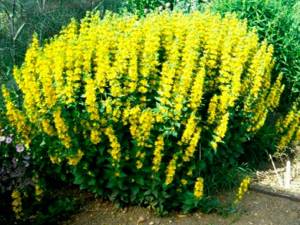
What time to plant
To propagate loosestrife, generative (seed) and vegetative methods are used. Seeds are sown in open soil in June or September (before winter). Almost all types of such plants prefer to grow in a shaded place or shade. At the same time, it is recommended to plant loosestrife in partial shade, but it can also grow in a well-lit area. But purple loosestrife can only be grown in an open, well-lit area.
Landing Features
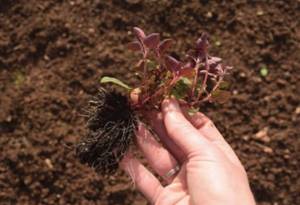
The area suitable for planting this flower must be moist with nutritious, loose soil, and the groundwater must be located very close to the soil surface. You should know that coined loosestrife, racemose loosestrife and common loosestrife can, if desired, be planted in a not very deep reservoir to a depth of no more than 10 centimeters. The composition of the soil can be anything, only loosestrife does not grow well on clay soil.
Loosestrife is planted after the soil has been fertilized with rotted manure or compost. The planting itself is no different from planting other garden plants. The root system of the plant must be placed in a pre-dug small hole, which is filled with soil, it must be compacted. Planted flowers need good watering. When planting, a distance of at least 50 centimeters should be maintained between bushes.
Loosestrife. Planting perennial loosestrife.
Loosestrife care
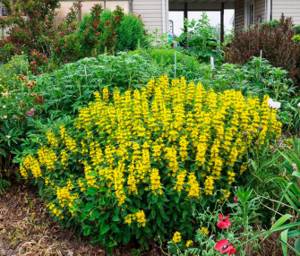
Growing loosestrife is relatively simple, and even an inexperienced gardener can cope with it. If the flower is planted on moist soil, then it does not need to be watered at all. However, during prolonged drought, you still need to water the loosestrife. There is no need to feed the plant during the growing season. However, humus should be added to the soil in late autumn.
Loosestrife is an invasive plant, especially the species called ciliated loosestrife, speckled loosestrife, or racemosa. To limit the growth of such a flower, you need to dig limiters around the bushes (plastic or metal pieces, or you can take unnecessary sheets of slate). If this is not done, then loosestrife will soon grow throughout the garden plot.
When flowering is over, you need to cut out all the faded inflorescences. In the autumn, all shoots of erect loosestrife need to be cut off.
Bloom
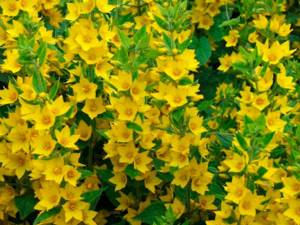
All types of this plant bloom at different times and have varying degrees of decorativeness. This will be discussed in more detail in the section “Main types and varieties.”
Transfer
In order for loosestrife to grow and develop normally, it must be replanted regularly. Such a flower can be grown in the same place for about 10 years. However, just a couple of years after planting loosestrife in open ground, it will become a developed bush that will have a large number of children. This bush definitely needs to be replanted. It is recommended to replant loosestrife at the beginning of the spring or in the fall, when the leaf fall ends.
Diseases and pests
This plant is highly resistant to both diseases and pests. Only aphids can settle on it, and you can get rid of them using a special product, for example, Antitlin or Biotlin.
Loosestrife point
The common loosestrife is well known to gardeners . A perennial plant, it forms dense dense bushes of upright, straight and strong stems, reaching a height of 80 cm and densely covered with oval-elongated leaves.
By the end of June, yellow star-bell-shaped flowers with an orange center open on the dotted loosestrife, which cover all shoots. At this time, the bush becomes very decorative. Flowering lasts more than a month.
Loosestrife point
Grows best in a semi-shaded location in moist soil. Under favorable conditions it can grow quickly, and then it has to be limited because it becomes aggressive and can crowd out neighboring plants. The 'Alexander' variety has leaves with a white border, the 'Golden Alexander' variety has a yellow border along the edge of the leaf.
Loosestrife, variety 'Alexander'
Reproduction of loosestrife
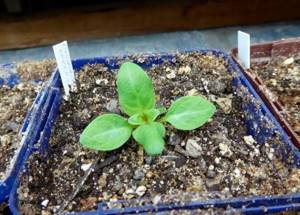
It was already mentioned above that loosestrife can be propagated by seeds, cuttings, dividing the bush, as well as by root shoots. Experienced gardeners prefer to propagate this plant by vegetative methods, since they are more reliable than generative (seed) methods. You should also remember that a bush grown from a seed begins to bloom only in the second or third year after the seedlings appear. Seeds are sown in the last days of May or the first days of June. However, the seeds must first be stratified for 6–8 weeks; to do this, they are placed on a refrigerator shelf intended for vegetables. If sowing of seeds is planned for autumn, then there is no need to prepare the seeds, because in the soil they will be able to undergo natural stratification and friendly shoots should appear in the spring.
You can grow loosestrife through seedlings. To do this, pre-stratified seeds must be sown, evenly distributing them over the surface of a moistened soil mixture, which should consist of peat and sand. Cover the container with glass and put it in a cool (about 15 degrees) and well-lit place. After 1.5–2 weeks, the first shoots should appear. Stronger plants should be picked into individual containers. Hardened seedlings are planted in open soil in June, and a distance of half a meter should be maintained between plants.
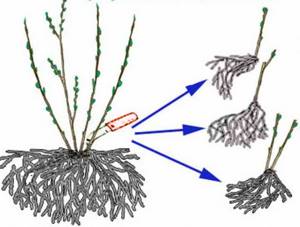
These flowers can also be propagated by dividing the bush. This procedure is carried out at the beginning of the spring period or in the fall during transplantation. First, it is necessary to separate the children from a bush dug out of the soil, then the bush itself is divided into several parts. It should be noted that each division must have well-developed roots and stems. Then they are planted in pre-prepared holes. Flowering loosestrife grown from cuttings can be seen as early as next season. The care for the divisions should be the same as for an adult plant.
To propagate the loosestrife, as a rule, cuttings are used, the length of which can vary from 0.1 to 0.2 m. The cuttings are harvested during the pruning process in the fall or in the spring. The lower cut of the cuttings must be immersed in water. When roots form on them, the cuttings should be planted in moist, loose soil, choosing an area in partial shade.
Types and varieties of loosestrife with photos and names
Below we will describe in detail those types and varieties of loosestrife that are most popular among gardeners.
Common loosestrife (Lysimachia vulgaris)
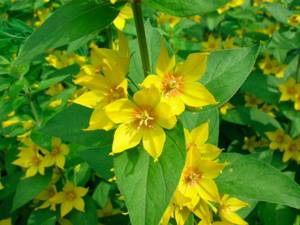
This herbaceous perennial plant can be found in natural conditions in North Africa and Eurasia, and it prefers to grow near swamps, meadows, forests and along the banks of various bodies of water. The height of the erect shoot varies from 0.5 to 1 m. The rhizome is creeping. The entire leaf blades have a lanceolate shape; they can be whorled or opposite. The lower surface has pubescence, and the upper surface is smooth. The bell-shaped flowers are yellow, with a brown-red spot at the base of the corolla. The flowers are part of the apical panicle-shaped inflorescences. Flowering occurs in June–August. This species is considered a honey plant; it is not afraid of stagnation of liquid in the soil. If desired, it can be grown in a shallow reservoir at a depth of no more than 10 centimeters.
Loosestrife (Lysimachia nemorum)

This species is found naturally in Europe. It prefers to grow near rivers and reservoirs, and such a plant rises from the foothills to the subalpine zone. This perennial plant reaches a height of about 0.3 m. The leaf blades are large and wide. Single yellow flowers are located on long stalks. Flowering begins in May and lasts eight weeks.
Loosestrife (Lysimachia thyrsiflora)

This flower prefers to grow in shallow water, as well as along the banks of reservoirs. The rhizome is creeping. Powerful, erect shoots reach a height of about 0.6 m. Narrow lanceolate-shaped leaf plates are most often planted. The small yellow flowers appear fluffy due to the fact that they have protruding stamens. These flowers are part of the fluffy axillary apical inflorescences, which reach about 30 mm in length. The beginning of flowering occurs in the last days of May or the first days of June.
Loosestrife (Lysimachia punctata)
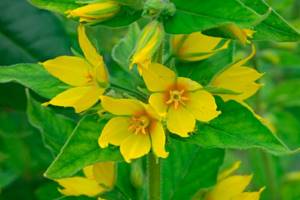
Found naturally in the forests of Central and Western Europe. At the end of a long rhizome there is a whorl consisting of 4–6 underground shoots. There is pubescence on the surface of erect shoots. Sessile leaf blades have a broadly lanceolate shape. The lemon-yellow flowers are located at the tip of the shoot, which is slightly branched. This species begins to bloom in the last days of June or the first days of July. Flowering duration is approximately 4 weeks. It is recommended to choose sunny areas for planting this species. The most popular varieties:
- Alexander . A white border runs along the edge of the green leaf blades.
- Golden Alexander . The green leaf blades have a golden border along the edge.
Loosestrife (Lysimachia congestiflora)

The homeland of this species is China. Such a plant is yellow - because it has many golden-yellow flowers, at the base of the petals of which there is a red smear. Lush, juicy foliage has a rich green color. We learned about this species relatively recently - in 1992. The following varieties are the most popular:
- Lissie . The spherical inflorescences are yellow in color. The foliage is green.
- Outback Sunset . This variety is variegated; the dark green leaf blades have a stripe of yellow color. The flowers are also yellow.
- Persian rug . Red veins are visible on the not very large dark green leaf blades. The flowers are yellow.
- Persian chocolate . The leaves are purple and do not die off in autumn. The flowers are golden yellow.
Lily of the valley (Lysimachia clethroides)

It occurs naturally in the southern part of Primorsky Krai. The pink-white rhizome of this flower is similar to that of the lily of the valley, but it is not as thin. The erect, leafy stem reaches only 0.2 m in height and has pubescence on its surface. Small snow-white flowers are part of dense spike-shaped inflorescences, reaching a length of 0.2 m. This loosestrife blooms in the last days of June. Flowering duration is about 15–20 days. This species has been cultivated since the end of the 20th century. The most popular varieties:
- Lady Jane . The height of the bush is 0.6–0.9 m. Flowering begins in the last weeks of summer.
- Geisha . Variegated variety. Along the edge of the leaf blades there is a cream-colored border.
Monetary loosestrife (Lysimachia nummularia), or coin loosestrife, or meadow loosestrife, or meadow tea

Under natural conditions, this species can be found in Japan, Europe and North America. This species prefers to grow in shady groves, on the outskirts of swamps, in floodplain meadows, as well as along the banks of various reservoirs and rivers. This perennial plant is a ground cover. The length of the recumbent stem is approximately 0.3 m. Opposite oval-shaped leaf plates have short petioles and a length of about 25 mm. Single axillary flowers are yellow and reach 25 mm in diameter. When a plant blooms depends directly on the light level. If the bushes are planted in a well-lit area, then flowering will begin in the last days of May or June. This species can form cover both on steep slopes and on flat surfaces. The Aurea variety is the most popular: the color of the leaf blades is green-yellow; this plant does not have high frost resistance compared to the main species.
Purple loosestrife (Lysimachia purpurea), or ciliated loosestrife (Lysimachia ciliata)
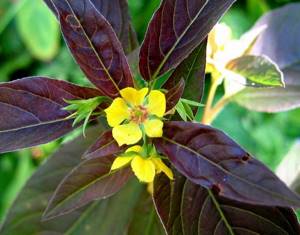
Under natural conditions, this species is found in North America. An erect perennial plant reaches a height of 0.45 m. The paired broadly lanceolate leaf blades have a wine-red color. Loose inflorescences consist of axillary small apical flowers of lemon-yellow color. This species blooms in August, and it is recommended to grow it in well-lit open areas.
Black-purple loosestrife (Lysimachia atropurpurea)

The birthplace of this plant is Greece. The height of this perennial plant can vary from 0.45 to 0.9 m. The composition of the very beautiful spike-shaped inflorescences includes a large number of flowers of a dark wine, almost black color. There is a small corrugation on the edge of the green leaf blades, which is especially clearly visible in young bushes. Flowering begins in the last days of July. The most popular variety is Beaujolais: the color of its flowers is dark purple.
Ephemeral loosestrife (Lysimachia ephemerum)
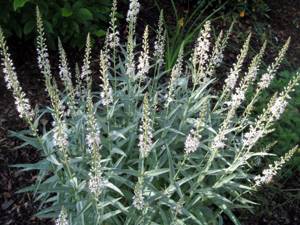
In the wild it is found in South-Western Europe. This perennial frost-resistant plant grows very quickly in width, and it can reach a height of about 0.9 m. In the last summer weeks, spike-shaped inflorescences consisting of flowers grow on the bush. Cultivated since the 19th century.
Common loosestrife
Common loosestrife is widespread in nature and is most often found in our gardens . Forms a wide bush consisting of straight, strong, slightly pubescent stems up to 1 m high.
Oval leaves are arranged oppositely in several pieces. It blooms from June to August with medium-sized bright yellow flowers located along the entire stem. During flowering, the plant looks very impressive - the entire bush consists of elongated yellow inflorescences.
Common loosestrife flowers This species loves slightly shady places and loose, well-moistened soil. And it even grows well in water at shallow depths, so it is well suited for placement in a flooded area or for creating a decorative swamp in the garden.
Properties of loosestrife: harm and benefit
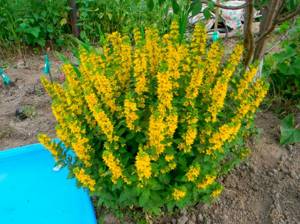
Medicinal properties of loosestrife
Common loosestrife has a strengthening, analgesic, wound-healing and hemostatic effect. However, traditional medicine does not pay any attention to this plant. At the same time, in alternative medicine, this flower is used for internal bleeding and diarrhea, as well as for the treatment of wounds that do not heal and fester for a long time, stomatitis, eczema and thrush.
This plant contains saponins, tannins, rutin, carbohydrates, silicic and ascorbic acid, so it is used quite widely in homeopathy. To treat abscesses, the foliage and flowers of the plant are used; it is recommended to apply fresh leaf plates to the wounds. A powder is prepared from the dried roots, which has analgesic properties, as well as the ability to heal burns and cuts.
Loosestrife infusion can stop internal bleeding. To prepare it you need to combine 1 tbsp. freshly boiled water and 1 large spoon of dried leaves. The infused and strained mixture should be drunk three times a day before meals, 1-2 large spoons.
Loosestrife tincture is used to restore strength after suffering a serious illness. To prepare it, you need to combine 1 tbsp. vodka and a couple of large spoons of fresh herbs. The well-sealed vessel is placed in a dark place for 3-4 days to infuse. The strained tincture is taken 20 drops 3 or 4 times a day.
Tea is also prepared from this plant, which is used for headaches and colds. To prepare it, you need to mix 1 large spoon each of rosemary leaves, chamomile flowers and loosestrife herb. Pour the mixture over a couple of glasses of freshly boiled water. After a few minutes the tea will be ready.
Use of loosestrife in landscape design and folk medicine
This plant gets along well with its moisture-loving counterparts, and is most often planted in combination with the following types of crops:
In addition, loosestrife has long been known for its healing properties. It contains useful components such as hyperin, rutin and phenolcarboxylic acids, as well as tannins, carbohydrates and ozone compounds.
In the video, the florist shows the common loosestrife and talks about how to properly care for this plant.
Infusions and decoctions from this plant are used for gastrointestinal disorders, skin inflammation, thrush, lung diseases and migraines. In addition, compresses soaked in fresh loosestrife juice will help reduce the pain of animal, insect and reptile bites and prevent complications.
Those who suffer from blood diseases, thrombosis, varicose veins and atherosclerosis should not be treated with loosestrife. It is also prohibited to give medicinal products based on this culture to people suffering from hypertension and children under 12 years of age.
